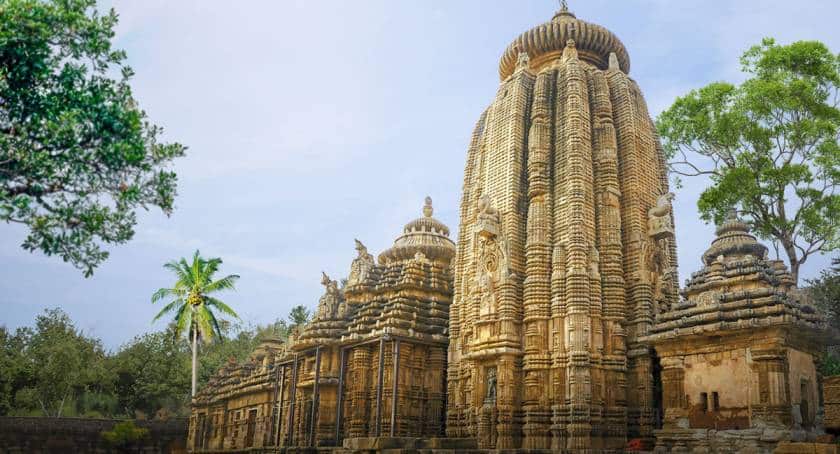Ananta Vasudeva Temple: A Pilgrim’s Haven
Ananta Vasudeva Temple, in the heart of Bhubaneswar, Odisha, is a magnificent tribute to Lord Krishna and a rare Vaishnavite shrine in a predominantly Shaivite city. Built-in the 13th century by Queen Chandrika Devi of the Eastern Ganga dynasty, this architectural wonder showcases the magnificence of Kalinga artistry. The temple enshrines unique idols of Krishna, Balarama, and Subhadra, resembling the deities of Jagannath Temple in Puri. Famous for its complex carvings, spiritual significance, and sacred Mahaprasad, it remains a vibrant center of devotion and festivals, offering visitors a look into Odisha’s rich cultural and religious heritage.
The Legend Behind Ananta Vasudeva Temple
Every ancient temple has a captivating story, and Ananta Vasudeva Temple is no exception. According to legend, Queen Chandrika Devi of the Eastern Ganga dynasty was a devout follower of Lord Krishna. She commissioned the construction of this temple in the 13th century to establish Vaishnavism in Bhubaneswar, which was predominantly a Shaivite center. The temple’s name, Ananta Vasudeva, refers to Lord Krishna as the eternal (Ananta) form of Vishnu, signifying his infinite presence and divine power.
The queen envisioned the temple to balance the region’s worship practices. While Bhubaneswar was home to the grand Lingaraj Temple, dedicated to Lord Shiva, she sought to create an equally magnificent shrine to honor Lord Krishna. Her devotion and commitment to Vaishnavism led to the establishing of a sanctuary that has stood the test of time, drawing devotees and historians alike to marvel at its spiritual and architectural grandeur.
Architectural Wonder of Temple
The Ananta Vasudeva Temple is a striking example of Kalinga architecture, which is known for its grandeur, complex carvings, and towering spires. Some of its key architectural features include:
- Majestic Vimana (Sanctum Tower): The towering vimana, built in the classical Rekha Deula style, resembles the Lingaraj Temple but houses idols of Lord Krishna, Balarama, and Subhadra instead.
- Beautiful Sculptures: Sculptors adorned the temple walls with sculptures depicting episodes from the Mahabharata, Ramayana, and Lord Krishna’s life.
- Jagamohana (Assembly Hall): This spacious hall serves as a gathering place for devotees and features stunning carvings of celestial beings, floral motifs, and mythological figures.
- Mukhashala (Front Porch): The entrance is decorated with elaborate carvings and acts as a transition from the material world to the divine realm within.
Deities, Lord Krishna in a Unique Form
Unlike most temples that depict Lord Krishna playing the flute, the Ananta Vasudeva Temple showcases a unique three-idol configuration:
- Krishna (Vasudeva): The central deity is adorned in divine attire and holds a conch, discus, club, and lotus, symbolizing his supreme power.
- Balarama (Balabhadra): Stands to Krishna’s right, depicted with a plow and a club, signifying his strength and agricultural connection.
- Subhadra: Subhadra, the divine sister of Krishna and Balarama, stands between them, like in the Jagannath Temple of Puri.
A Hub of Bhakti and Rituals
The Ananta Vasudeva Temple is an architectural wonder and a vibrant center of devotion and rituals. Daily worship includes morning aarti, bhajans, and unique offerings to the deities. The temple follows the Vaishnava tradition and celebrates Krishna Janmashtami with grandeur, drawing thousands of devotees annually.
The Famous Mahaprasad as a Culinary Delight
One of the temple’s major attractions is its Mahaprasad, a sacred offering prepared in the temple kitchen and served to devotees. The temple cooks the food using traditional methods, just like the Jagannath Temple’s Mahaprasad. The offerings include rice, dal, vegetables, and sweets, all prepared without onions or garlic. Devotees believe that eating this sacred food brings spiritual merit and divine blessings.
The Temple’s Connection to Jagannath Culture
The Ananta Vasudeva Temple shares a deep connection with Jagannath culture, which is evident in its architectural design, rituals, and religious traditions. The temple resembles the famous Jagannath Temple in Puri, as both enshrine a triad of deities- Lord Krishna (Vasudeva), Balarama, and Subhadra. Like the Puri temple, Ananta Vasudeva Temple follows similar worship practices, including daily rituals and festive celebrations dedicated to Lord Vishnu. One of the most significant aspects of this connection is the tradition of Mahaprasad, a sacred offering prepared and distributed to devotees in a manner akin to Puri’s temple. This spiritual and cultural link makes Ananta Vasudeva Temple a revered pilgrimage site for Lord Jagannath and Vaishnavism followers.
Festivals and Celebrations
During significant Hindu holidays, the temple comes to life, particularly:
- Krishna Janmashtami: Devotees perform special rites, kirtans, and bhajans to commemorate the birth of Lord Krishna.
- Ratha Yatra: Inspired by the Puri Ratha Yatra, this festival involves grand processions of the deities.
- Dola Purnima: The festival of colors, where devotees celebrate Lord Krishna’s playful nature.
An Eternal Symbol of Devotion
The Ananta Vasudeva Temple is an ancient structure and a legacy of faith, art, and history. It offers something significant for everyone, whether you are a traveler hoping to experience Odisha’s rich legacy, a history buff studying old architecture, or a devotee seeking spiritual comfort. A visit to this divine sanctuary lingers in the heart, echoing the timeless devotion of millions who have bowed before its sacred walls.


